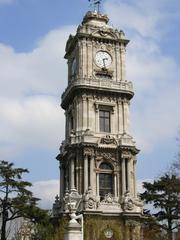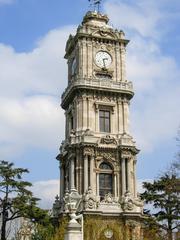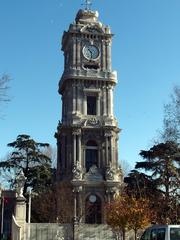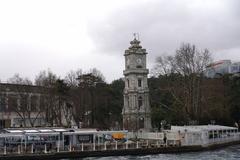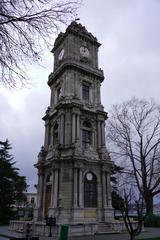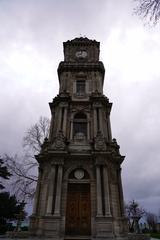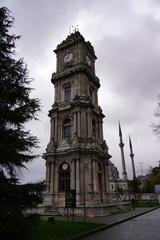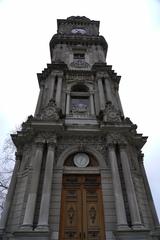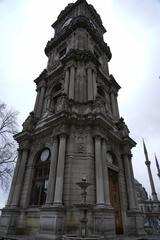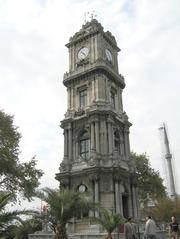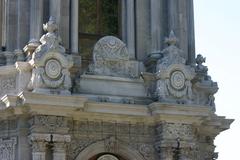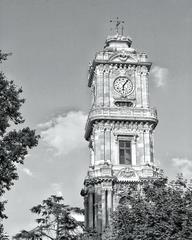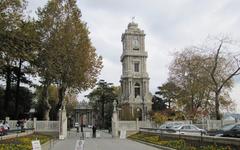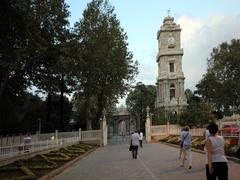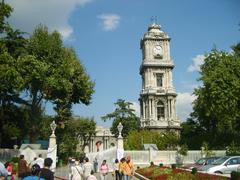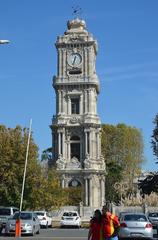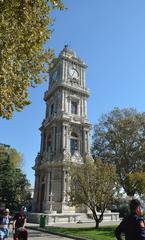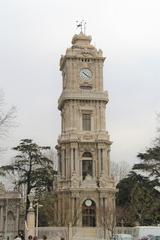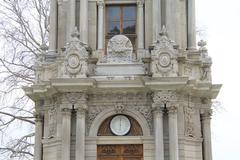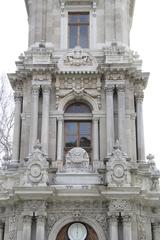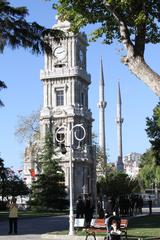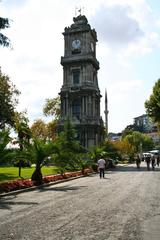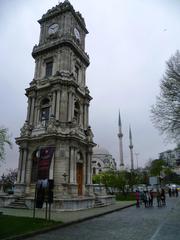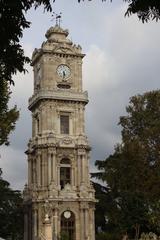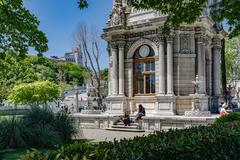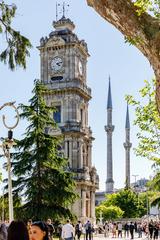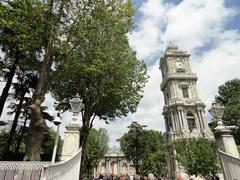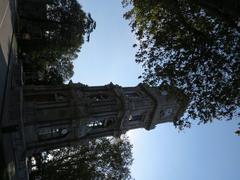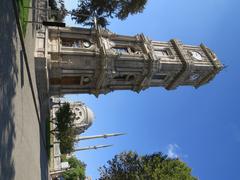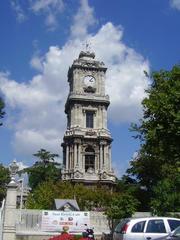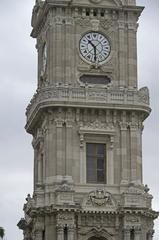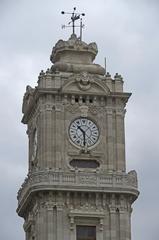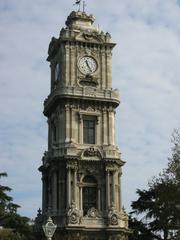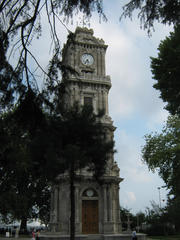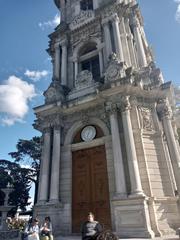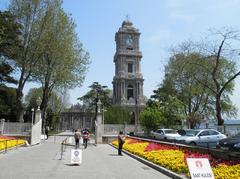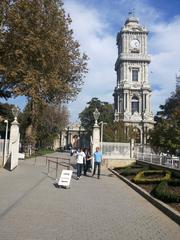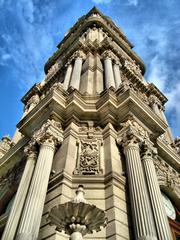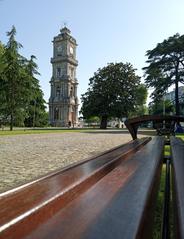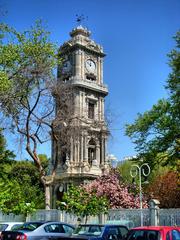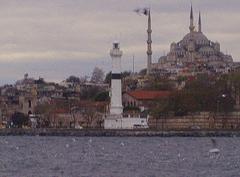
Dolmabahçe Clock Tower in Istanbul: A Comprehensive Guide
Date: 18/07/2024
Introduction
The Dolmabahçe Clock Tower, an architectural marvel nestled within the Dolmabahçe Palace complex on the European shores of the Bosphorus in Istanbul, stands as a striking symbol of the Ottoman Empire’s rich history and its transition into modernity. Commissioned by Sultan Abdülhamid II and designed by the renowned Armenian architect Sarkis Balyan, the tower was completed in 1895. This elegant structure serves as a functional timepiece and a testament to the eclectic architectural tastes of the late Ottoman period, blending Ottoman, Baroque, Rococo, and Neoclassical styles. The clock tower’s construction coincided with a period of significant modernization and reform within the Ottoman Empire, symbolizing the empire’s efforts to embrace progress while preserving its cultural identity (source).
Standing at an impressive height of 27 meters (89 feet), the Dolmabahçe Clock Tower features intricate stonework, ornate clock faces, and a harmonious fusion of Eastern and Western architectural elements. This guide provides an in-depth exploration of the clock tower’s historical significance, architectural beauty, and essential visitor information, offering insights into one of Istanbul’s most iconic landmarks.
Table of Contents
- Introduction
- Historical Significance and Background
- Architectural Details and Design
- Visitor Information
- Restoration and Preservation
- Interesting Facts
- Conclusion
- FAQ
- Call to Action
Historical Significance and Background
A Gift to the Sultan
The Dolmabahçe Clock Tower, commissioned as a gift to Sultan Abdülhamid II by his mother, Bezmialem Sultan, was designed by the renowned Armenian Ottoman architect Garabet Amira Balyan. Balyan, celebrated for his work on the opulent Dolmabahçe Palace, completed the clock tower in 1853.
Architectural Fusion - Ottoman and Baroque
The tower’s design reflects the eclectic architectural tastes prevalent during the late Ottoman period. Standing 27 meters tall, the four-story structure beautifully blends Ottoman and European, particularly Baroque, architectural elements.
- Ottoman Influences: The tower’s slender, tapering form, reminiscent of minarets found in traditional Islamic architecture, speaks to its Ottoman roots. The intricate stonework and decorative motifs adorning the facade further enhance its oriental charm.
- Baroque Flourishes: The European Baroque influence is evident in the tower’s ornate clock faces, the elaborate cornices, and the decorative columns. The use of white marble, a material favored in European architecture of the time, further emphasizes this stylistic fusion.
A Symbol of Modernization
The Dolmabahçe Clock Tower, beyond its aesthetic appeal, served a crucial symbolic function. It represented the Ottoman Empire’s embrace of Western technology and its desire to project an image of modernity to the world.
- Accurate Timekeeping: The clock’s mechanism, imported from France, ensured precise timekeeping, a stark contrast to the often-unreliable traditional timekeeping methods. This accuracy symbolized the empire’s commitment to progress and efficiency.
- Public Display of Time: Unlike earlier times, when time was primarily a concern for religious authorities, the Dolmabahçe Clock Tower made time a public matter. The prominent clock faces, visible from afar, announced the empire’s adoption of standardized timekeeping, a hallmark of modern administration and urban life.
A Witness to History
Over the years, the Dolmabahçe Clock Tower has stood as a silent observer to the ebb and flow of history. It witnessed the twilight years of the Ottoman Empire, the rise of modern Turkey, and Istanbul’s transformation into a bustling metropolis.
- From Empire to Republic: The tower saw the reign of the last Ottoman Sultan, Mehmed VI, and the subsequent dissolution of the empire. It later witnessed the birth of the Republic of Turkey under the leadership of Mustafa Kemal Atatürk.
- A City’s Evolution: The clock tower has observed Istanbul’s dramatic growth and modernization. From its vantage point, it has seen the city expand beyond its historic peninsula, embracing new architectural styles and urban planning concepts.
Architectural Details and Design
Architectural Style and Influences
The Dolmabahçe Clock Tower embodies a unique blend of architectural styles, reflecting the eclectic tastes prevalent during the late Ottoman period. While predominantly Ottoman in its core, the tower incorporates elements of Baroque, Rococo, and Neoclassical styles, resulting in a harmonious fusion of Eastern and Western aesthetics.
Structure and Dimensions
The tower stands at an impressive height of 27 meters (89 feet). Its four-tiered structure rises gracefully from a square-shaped base, gradually tapering towards the top, culminating in a pointed dome crowned with an ornate finial.
Materials and Construction
Built with meticulous care and precision, the tower showcases the finest materials available during its time. The structure primarily comprises white marble sourced from the Marmara Island, renowned for its pristine quality and luminosity.
Facade and Ornamentation
The tower’s facade is a visual delight, richly adorned with intricate details and embellishments that exemplify the Ottoman penchant for ornate decoration.
- Intricate Stonework: The exterior surfaces are lavishly decorated with intricate stone carvings, featuring floral motifs, geometric patterns, and calligraphic inscriptions.
- Clock Faces: Four prominent clock faces, each facing a cardinal direction, are set within elaborately decorated frames on the tower’s upper level.
- Balconies and Columns: Each level of the tower features arched windows and balconies framed by slender columns, adding a sense of verticality and rhythm to the structure.
Interior Design and Features
While the tower’s exterior is undeniably captivating, its interior, though not accessible to the public, is said to be equally impressive.
- Grand Staircase: A grand staircase, crafted from polished marble and adorned with ornate balustrades, is believed to wind its way up the tower’s interior, leading to the clock mechanism chamber.
- Clock Mechanism: The tower houses a complex and precise clock mechanism, a testament to the technological advancements of the late 19th century.
Visitor Information
Dolmabahçe Clock Tower Visiting Hours and Tickets
- Visiting Hours: The Dolmabahçe Clock Tower is open to visitors from 9:00 AM to 5:00 PM, Tuesday through Sunday. It is closed on Mondays and on national holidays.
- Ticket Prices: Entry to the Dolmabahçe Clock Tower is included with a ticket to the Dolmabahçe Palace. Tickets cost approximately 120 Turkish Lira for adults, with discounts available for students and seniors. Tickets can be purchased at the palace entrance or online through the official Dolmabahçe Palace website (source).
Travel Tips
- Getting There: The Dolmabahçe Palace complex is easily accessible by public transport, including tram, bus, and ferry services. The nearest tram stop is Kabataş, just a short walk from the palace.
- Best Time to Visit: The best time to visit is during the early morning or late afternoon to avoid the crowds. Don’t forget to bring a camera to capture the stunning views of the Bosphorus.
Nearby Attractions
While visiting the Dolmabahçe Clock Tower, explore other nearby attractions such as the Dolmabahçe Palace, the Beşiktaş district, and the Istanbul Naval Museum.
Accessibility
The Dolmabahçe Clock Tower and the surrounding palace complex are wheelchair accessible. However, some areas may have uneven surfaces, so caution is advised.
Guided Tours
To gain deeper insights into the history and architecture of the Dolmabahçe Clock Tower and Palace, consider joining a guided tour. These tours are available in multiple languages and provide a comprehensive understanding of the site’s significance.
Photographic Spots
The clock tower offers numerous photographic opportunities. Capture the intricate details of the stonework, the stunning views of the Bosphorus, and the majestic backdrop of the Dolmabahçe Palace.
Restoration and Preservation
Despite its enduring presence, the Dolmabahçe Clock Tower, like many historical structures, has faced the test of time. In 1979, it underwent a significant restoration to address wear and tear. This meticulous restoration ensured the preservation of its architectural splendor and historical significance for generations to come.
Interesting Facts
- Timekeeping Precision: The Dolmabahçe Clock Tower, despite its age, is renowned for its accurate timekeeping. Its mechanism, a testament to the craftsmanship of the era, continues to function reliably, keeping time for the city even today.
- Gift of a Sultan: The clock tower was a gift from Sultan Abdülhamid II to his mother, Valide Sultan Pertevniyal. This gesture reflects the importance of timekeeping and the grandeur associated with such gifts during the Ottoman era.
- Architectural Fusion: The clock tower’s design beautifully blends Ottoman and European architectural styles, reflecting the trends prevalent during the reign of Sultan Abdülmecid I. This fusion is evident in the intricate details, the choice of materials, and the overall aesthetic of the tower.
- Symbolic Significance: Beyond its functional purpose, the Dolmabahçe Clock Tower holds symbolic significance. Its imposing presence served as a reminder of the sultan’s power and the empire’s grandeur. The clock’s visibility from afar further emphasized this message, reaching beyond the palace walls.
- Connection to Maritime History: The clock tower’s location, overlooking the Bosphorus, was strategically significant. It served as a visual marker for ships navigating the strait, further highlighting the empire’s maritime prowess.
- Enduring Legacy: Today, the Dolmabahçe Clock Tower stands as a testament to Istanbul’s rich history and architectural heritage. It serves as a popular tourist destination, attracting visitors from around the globe who marvel at its beauty and historical significance.
- Cultural Representation: The clock tower has been featured in numerous films, television shows, and literary works, solidifying its place in popular culture. Its image is often used to represent Istanbul’s unique blend of history, culture, and architectural splendor.
- Restoration Efforts: Over the years, the Dolmabahçe Clock Tower has undergone meticulous restoration efforts to preserve its structural integrity and aesthetic beauty. These efforts ensure that future generations can continue to appreciate this architectural masterpiece.
FAQ
Q: What are the Dolmabahçe Clock Tower visiting hours? A: The Dolmabahçe Clock Tower is open from 9:00 AM to 5:00 PM, Tuesday through Sunday.
Q: How much do tickets to the Dolmabahçe Clock Tower cost? A: Tickets cost approximately 120 Turkish Lira for adults, with discounts for students and seniors.
Q: Is the Dolmabahçe Clock Tower accessible for wheelchair users? A: Yes, the tower and the surrounding palace complex are wheelchair accessible, though some areas may have uneven surfaces.
Q: Can I join a guided tour of the Dolmabahçe Clock Tower? A: Yes, guided tours are available and offer comprehensive insights into the site’s history and architecture.
Q: What other attractions are near the Dolmabahçe Clock Tower? A: Nearby attractions include the Dolmabahçe Palace, Beşiktaş district, and the Istanbul Naval Museum.
Call to Action
Don’t miss the opportunity to explore one of Istanbul’s most iconic landmarks. Plan your visit to the Dolmabahçe Clock Tower today and immerse yourself in the rich history and architectural beauty of the Ottoman Empire. For more updates, follow us on social media and check out our related posts on Istanbul’s historical sites and travel tips.
Conclusion
The Dolmabahçe Clock Tower remains a proud symbol of Istanbul’s rich historical tapestry and architectural splendor. Serving as a bridge between the past and the present, the tower reflects the Ottoman Empire’s quest for modernization and its embrace of diverse cultural influences. Its strategic location overlooking the Bosphorus, combined with its intricate design and enduring legacy, makes it a must-visit landmark for history enthusiasts and tourists alike. Whether you are captivated by its architectural fusion, intrigued by its historical significance, or simply seeking a picturesque spot in Istanbul, the Dolmabahçe Clock Tower offers a unique and enriching experience. Plan your visit to this historical marvel to witness the grandeur and elegance that have stood the test of time (source).
